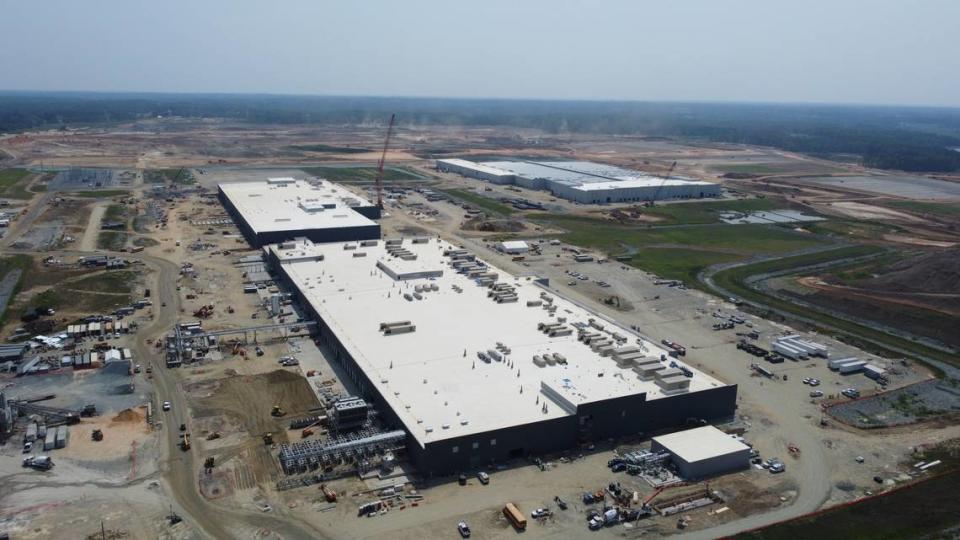What does clean energy economic development mean in NC? Billions, says new report.
Clean energy businesses opening up factories and other investments in North Carolina are expected to contribute billions of dollars to state and local economies while they’re being built and hundreds of millions after, according to a new analysis.
E2, a nonpartisan group of environmental business leaders, analyzed nine clean energy projects announced in North Carolina in the year after the federal Inflation Reduction Act passed, August 2022 to August 2023.
The E2 analysis found that nine projects announced over that period totaled $10.1 billion in economic investment, with another $1 billion in annual investments over the lifetime of the facilities. It also estimated that the projects would generate $7.6 billion in income during the construction phase, followed by $380.4 million in income when the facilities were operating. That would mean $10.2 billion added to the state’s gross state product during construction and $593.5 million to the GSP annually during the life of the facilities.
Those projects included a $2.5 billion expansion of Toyota’s Liberty battery plant announced in August 2022 and another $2.1 billion expansion announced in May 2023. They also included Wolfspeed’s $5 billion chip manufacturing facility in Siler City and Kempower’s $41 million electric vehicle charger facility in Durham. The projects were among the 300 clean energy manufacturing facilities announced nationwide in the year after the Inflation Reduction Act, which contained tax credits and other forms of incentives, was signed.
“I really do believe we’re at the advent of an American economic revolution, the likes of which we haven’t seen in generations. And North Carolina really is at the center of it all,” Bob Keefe, E2’s executive director, told The News & Observer.
Keefe, a North Carolina native, features North Carolina-based Trane Technologies’ heat pump manufacturing in his new book, “Clean Economy Now: Stories From the Frontlines of an American Business Revolution.”
The nine North Carolina projects are estimated to support a total of 24,600 jobs while they are being built and at least 5,400 more jobs during their operational life.
“Even if you’re not working at the Toyota plant building EVs, even if you don’t put solar panels on your roof, you’re probably benefiting form these projects that are flowing to the state of North Carolina because it creates jobs and sales at the local restaurant, the local retailer and the local real estate firm,” Keefe said.
David Rhoades, an N.C. Department of Commerce spokesman, said the E2 report is “directionally correct.”
Of the nine projects included in the report, Commerce has provided Job Development Investment Grants for eight. Commerce officials estimate that those projects will have a combined economic impact of $56.1 billion while the grants are active, Rhoades wrote, adding that the long-term impacts could be larger.
“The E2 report confirms the power of North Carolina’s value proposition for business. We offer a strong manufacturing and construction workforce, a favorable business climate, and an educational ecosystem focused on preparing students for the clean energy jobs of today and tomorrow,” Rhoades wrote.
‘Very reasonable’ economic analysis
The methodology E2 used to conduct its economic impact analysis is standard, Mike Walden, a retired N.C. State University economist, said in an interview after reviewing the report.
E2’s analysis looked at ‘direct’ economic effects caused by hiring employees who will build and work at the nine projects; potential ‘indirect’ impacts like new employees that could be hired to support companies that supply the announced projects; and ‘induced’ effects caused by workers at the facility buying houses, groceries and products locally.
“Looking at their numbers, they are very reasonable,” Walden said.
Walden designed a set of formulas, called the Walden Model, that the N.C. Department of Commerce uses when crafting an incentive package to determine an economic development project’s impact. The goal of the models is to capture the full scope of the project so the state can assure the project is generating more benefits than North Carolina is offering in incentives, The N&O previously reported.
Walden says that he refers to the U.S. 64 corridor between the Triangle on the east and the Triad on the west as the “energy transformation corridor,” particularly because of the Toyota, VinFast and Wolfspeed projects that are all located nearby.
“I would expect more firms located along that corridor to feed in. So that’ll be interesting to watch,” Walden said, referencing the potential addition of new suppliers and other smaller companies that can work with the three large projects.
For example, in February Fujihatsu and Toyotsu’s announced a $60 million facility near the Liberty plant that will make aluminum cell cases and cell covers for batteries, supporting the Toyota plant.
The analysis is the second in about a month that is highlighting the clean energy economy’s impact in North Carolina. An Environmental Defense Fund report found that companies have announced $19.2 billion in electric vehicle or battery manufacturing projects in recent years, including $8.9 billion in new investments from August 2023 to March.

This story was produced with financial support from the Hartfield Foundation and Green South Foundation, in partnership with Journalism Funding Partners, as part of an independent journalism fellowship program. The N&O maintains full editorial control of the work. If you would like to help support local journalism, please consider signing up for a digital subscription, which you can do here.

